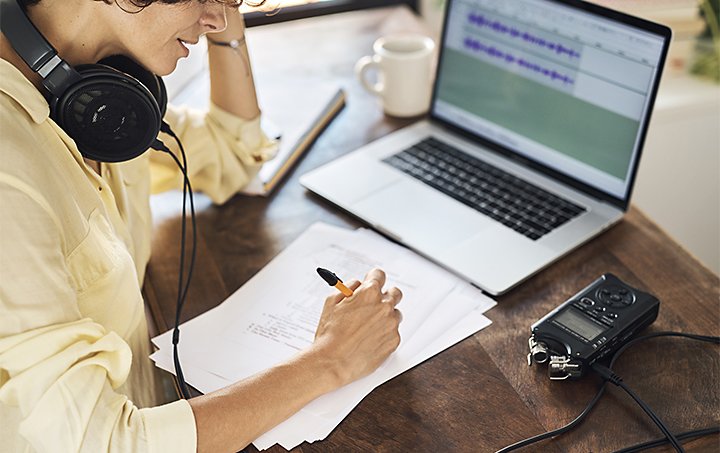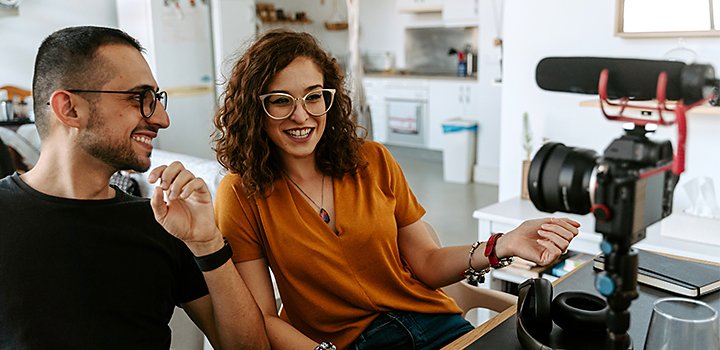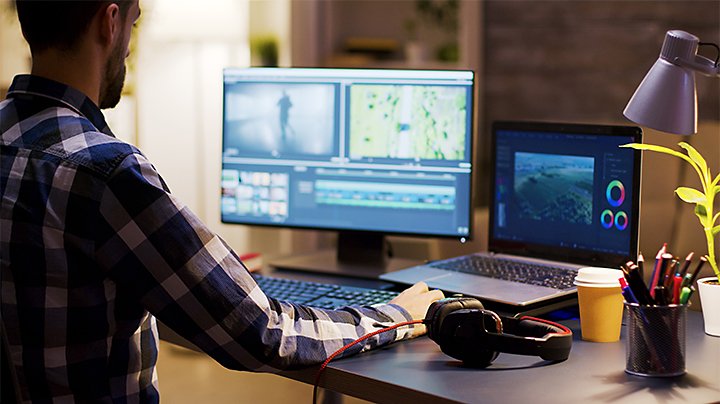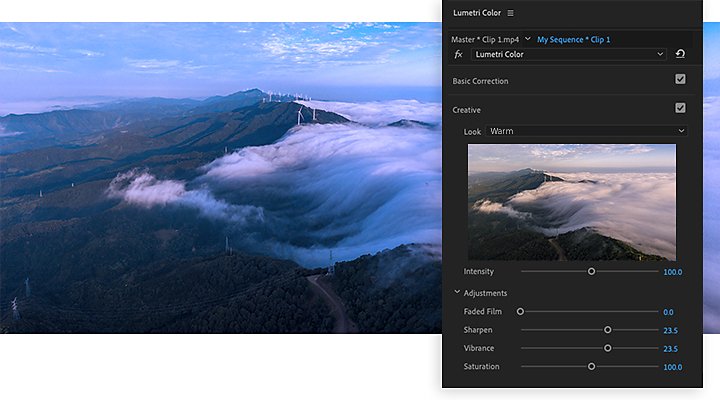How to make a movie.
From first draft to post-production, get an overview of the filmmaking process with these tips from professional filmmakers.
The three phases of moviemaking.
Whether you want to make a low-budget short film or Hollywood feature, you can break down the process of making your own movie into three major phases: pre-production, production, and post-production. An understanding of the entire process can help ensure you make the most of your time and money to set yourself up for creative success.
Do your homework in pre-production.
Much of the work of moviemaking happens long before anyone picks up a camera or camcorder to begin principal photography.
Turn your idea into a screenplay.
The first version of any film isn’t a movie at all but a screenplay. Once you have an idea, write the script or hire a screenwriter. Consider your intended audience. What do they want to see? Will your storyline draw them in and will they stick with your characters?
“Think about going down the road of distribution and selling the film to people. You’ll have to prove to them that there is an audience for this project,” says director Greg Emetaz.

Screenwriting is mostly about revision. Show the script to people whose opinions you trust, and revise it based on their feedback. Repeat this process a few times. Use storyboarding to test out the action, camera angles, and ideas for camera movement.
The development phase varies depending on the scale of the movie. “In smaller independent projects, that process is mostly about trying to just raise money. On bigger projects, a studio may have an idea for a movie, and they need to hire all the people to make that happen,” says Emetaz.
While you refine the screenplay, begin to think about how you can turn that blueprint into a film. How much will it cost to properly shoot the film you’ve written? Your first hire may be a line producer, production manager, or assistant director with the knowledge and experience to estimate what you’ll need in terms of personnel, sets, costumes, and equipment.
“Find somebody who loves pre-production,” says director and teacher David Andrew Stoler. “Someone who grooves on doing spreadsheets, making phone calls, putting things together. If they’re someone you trust and work well with, they will be a huge help.”
Don’t lose heart if the first cost estimates are eye-poppingly high. You can revise the script and scale your ideas down to the movie you have the budget to make. “If you have a $200 million idea, but you try to make it for $50,000, it rarely works unless it’s a satire. If it’s full of nothing but action sequences that involve flying, but you don’t have the resources to make that happen, it’s a doomed situation,” says Emetaz.

Gather your cast and crew.
From the cinematographer to the costume and set designers, everyone should share the director’s vision and be willing to invest themselves in the work. (Personal connections to film festivals or distributors don’t hurt either.) “Production is a long, collaborative process, and someone who isn’t game can be a real anchor on the whole thing,” says Stoler.
Be clear about what you expect, but also find out what your crew members want to get out of the film. “I really want to know what they are interested in doing,” Stoler says. “If people feel respected, if they’re given an opportunity to grow and stretch themselves — do something a little out of their range — then they are much more likely to give you much more and try much harder.”
Make the most of the talent around you. “The best projects are ones in which the director guides the vision but doesn’t dictate it. And that means ditching your ego and really listening to people’s opinions about what should happen,” Stoler says.
It takes a lot of money to make a movie, so raise as much as you can. But you should also consider the other resources available to you. “First-time filmmakers, who have to do a lot on a very small budget, should think about other resources, like people who can help you and locations you can use,” Stoler says.
The more prepared you are for production before it begins, the better off you’ll be. “Things will change, but if you at least go into everything with a good shot list or storyboards, it will be much easier to pivot at the last minute,” says Emetaz. If you know a scene will require elaborate costumes, you can budget time and personnel for getting actors in and out of them.
Through meticulous preparation, you can learn exactly what you can do on your budget. “It’s a lot easier to cut things at this stage than to get halfway through production and run out of money,” says Emetaz. Stoler recommends creating a spreadsheet of every 15 minutes of every shooting day, so every member of cast and crew knows where they need to be and what they need to do at all times. This level of planning will also help you know what you need to do to set up every location and determine equipment rental and insurance needs.
Budget for as much shooting time as you can because you’ll always feel short of time on set. “Expect your director of photography to underestimate how long everything will take, so add space for things to take longer than you thought,” says Stoler.
Every new shot takes time to set up, so if you have crew members, you can multitask. While you shoot the first shot, set design can work on the second shot and your gaffer can figure out how to get good lighting for it. The key is to schedule all of that and make sure everyone has the schedule. “This is the magic of the spreadsheet,” Stoler says.
Tips for a successful production.
You’ve made your plan and hired everyone (or, if you have no budget, called in all your favors). You have a schedule, locations, equipment, costumes, and props. Now it’s time to block scenes, or figure out how the actors will move in relation to the camera. While the actors rehearse, you can set up and adjust the lighting. Finally, make sure the camera is rolling and the microphones are recording, and you’re ready to start shooting your film.
“It’s always unexpected things that go wrong,” says Emetaz. He recalls trying to shoot a canoeing scene only to discover that the actor didn’t know how to paddle a canoe. “That was a huge problem no one anticipated. You’re just trying to knock off all the things that you need to shoot to complete the film, and you’re going to constantly run into problems.”
Make backup plans. Set up contingencies that account for the unexpected. “It’s really an insane battle against time, because every second is really expensive,” adds Emetaz.


Lean on your people.
“It’s very hard as a director to focus on the work when everything’s exploding around you, so make sure you have people who can handle those explosions for you,” says Stoler. “You should have at least one person whom you trust 100 percent to take care of things.”
When problems arise, especially with indie film production, you have to consider the budget as you seek solutions. You may not be able to afford some of the elaborate cinematography you wanted to create. It helps to focus on the truly essential shots if you focus on your viewers.
“What is going to help the audience be engaged with the story and understand it? What do we really need from this scene? Do we need seven different shots? Do we need the helicopter shot, or do we just need a close-up of someone showing concern?” Emetaz says. “Think about what will be seen on screen as opposed to what the plan was.”
Put it all together in post-production.
Find the story in your footage. Harness all of your editing knowledge, whether it’s from film school, obsessive love of film, or online tutorials, to make the best film you can. Then spread the word.
“There are three films in every film. The first is the one that you thought of and wrote. The second is the one that you shot. And the third is the one that you create in the edit,” says Stoler. Just as surprises change the film in production, they can change it in the editing room, and you have to be willing to go with the changes.

Especially when there’s no option to reshoot, video editing is largely about problem solving. “It’s a lot of beautiful, creative artistry, but it’s also fixing everything that went wrong,” Emetaz says. “Again, you’re thinking about the audience and what they’re going to experience. They didn’t see the storyboards or read the script. All they’re going to see is what you shot, so embrace what you’ve got.”
Try out different cuts and different scene orders. “Don’t lock yourself into your initial vision, because it’s probably not the best picture in there,” Stoler says. “Look at what you have, and be willing to change everything.”
Save your work in your editing software constantly. With Adobe Premiere Pro, the industry-standard editing program, you can save everything to the cloud as you work. Be methodical about versions and backups, and experiments you attempt. When you’re happy with an assemblage, go through making sure every cut is intentional and has meaning.
Then put the film aside for a while. Come back to it with fresh eyes and cut it relentlessly. Show it to people. Do a few cycles of that work. “Lock yourself up and don’t come out for a year,” Stoler says. Once you have a rough cut you’re happy with, then you can perfect the dialogue, sound effects, and music.

Finally, the film is ready for color correction and color grading. With subtle changes, you or your editor can shift mood and tone, and improve the look of the whole film or highlight certain scenes.
With your final cut in hand, ask everyone you know to promote your film. “Just like with pre-production, you want to have someone who's great at talking to people and getting in touch with people.” Though there are more channels to distribution, without promotion no one will see your film.
Start with a trailer and poster.
If you want to get into film festivals or get distributors excited about the film, you need to make a trailer or sizzle reel. The film poster is also extremely important in the age of online streaming platforms. The first and only exposure someone may have to your film is that thumbnail image, so again consider your audience and what might draw them in.
One way to get attention, especially for smaller films, is to submit your film to festivals. There are thousands of film festivals around the world every year, so don’t worry if you can’t get into Sundance. “Once it’s in film festivals, distributors might contact you or it may win an award, and that generates attention,” says Emetaz.
Another way to get distribution for your film is to hire a distribution agent. “For a percentage, they will reach out on your behalf. Foreign sales work almost exclusively through distribution agents,” says Emetaz.
By the end of your first movie, you are so much wiser (and a little older) than you were at the beginning. Now take that knowledge and put it to work on the next one.
Contributors
Do more with Adobe Premiere Pro.
Make visually stunning videos virtually anywhere — for film, TV and web.
You might also be interested in…
Discover the process of making a video or film, from first draught to final cut.
Heighten the artistry, efficiency and emotional depth of your work with these useful techniques.
Get B-roll footage that makes video editing easier and helps you to keep your audience engaged.
Low-key and high-key lighting.
Learn about the artistic benefits of high key and low key lighting in videography.
Get Adobe Premiere Pro
Create flawless productions with the industry-leading video editing software.
7 days free, then 26,43 €/mo.



